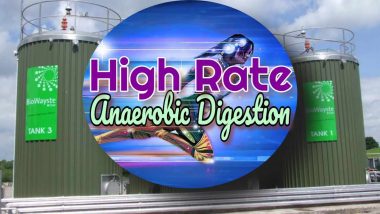We bring you our top Silage Clamp Tips here because biogas plant silage storage is one of the least discussed aspects of anaerobic digestion. But it is important. It provides a feed store for times when other feedstocks may be in short supply. But every silage clamp needs a lot of care for successful clamp operation. So read on for our Top 12 Silage Clamp Tips for success including the use of clamps for Biogas Digester Feedstock Storage.
One thing a digester operator always needs is the ability to feed the digester every day of the year.
The key is to run a good silage clamp.
Success with silage can mean the difference between a profitable crop-waste based biogas plant and a liability.
Top 12 Silage Clamp Tips
In the video embedded below, we provide our, top dozen silage clamp tips. These are top tips for the care and legally compliant operation of AD feedstock storage in the UK, in accordance with the Defra SSAFO regulations.
Each of the 12 tips is listed and explained in the video above, and again below. Watch our video presentation and afterwards return for more information about Anaerobic Digestion Plant UK SSAFO compliant silage clamps.
- Silage clamp design and installation must comply with the UK silage clamp regulations (SSAFO Regs (UK))
- Silage clamps constructed with earth bank walls dug into the field with no other sealing are not SSAFO compliant.
- The weight of machinery used to compact clamps today is significantly higher than a conventional silage clamp is designed to support. Many are still being built to the same specifications as years ago. When designing always be sure to use the latest design criteria.
- Concrete retaining wall suppliers say that the most cost-effective silage wall heights are up to 3m. However, they can provide precast walls of 4m high, which can be beneficial for larger clamps and those at anaerobic digestion plants.
- It’s important to choose an oxygen barrier film/ cover membrane that will closely follow and cling to the clamp’s surface. This is needed to prevent pockets of trapped air from forming which can significantly cause aerobic spoilage on the top and shoulders of clamps.
- Leaving clamps open at both ends while feeding the digester increases the overall footprint without any meaningful operational benefits.
- Placing a layer of at least a grab depth of fresh grass on top of a whole crop (e.g. maize silage) filled clamp prior to sealing the clamp and consolidating can improve silage quality.
- Make every effort to ensure that your silage making clamps are well maintained, including all pipework and tanks as well. The need for costly polluted water cleanups is easily prevented in this way.
- In the UK Environment Agency’s (EA) regulatory fees charged are related to their costs in monitoring each biogas facility and storage clamp. Avoiding any non-compliance incidents which might flag a digester operation as needing special attention from the regulator will minimise licencing fees.
- Ensure that silage AgBags, which are a concern to the EA and may lead to increased AE inspections, are always secure, well maintained and in the correct position.
- There’s always the urge to stuff that extra piece of silage into the silage pit/clamp, but doing so may be exceedingly dangerous since it can cause the surrounding walls or silage pit/clamp to collapse, especially when dealing with overly wet grass.
- The effects of both air stress during storage and exposure to air at feed-out reduce biogas yields. Tests on seven days of feed-out exposure to air, have been reported to show up to 17% of the methane potential of maize was lost without applying an additive.
What is a Silage Clamp?
Silage is grass or other crops which are cut fresh and packed in a large volume in a pile, or “clamp”. The pile is in effect pickled in its own juice. by sealing out the air, and it does not rot or compost.
The silage is formed either in big bales which are carefully covered completely in a sealed plastic bag or wrapper or in a “clamp”.
Both, are used by the farming operators of anaerobic digestion plants, and they provide an invaluable year-round feedstock for a biogas digester.
Silage Essential to Smoothing Feedstock Changes and Avoiding Shock Loadings Should be Small in Proportion to Waste Biomass Feeding

An experienced biogas plant operator constantly seeks to adjust the feedstock of the plant by juggling feed materials to keep the input of feed biomass as constant as possible. The consistency of key nutrient supplies is simply one of several features of a digester feedstock that must be evaluated and managed such that fluctuations are gradual. Shock feedstock loadings are studiously avoided.
Anaerobic digestion plants rely on the well-being of the organisms that produce methane in order to produce biogas. The make-up of the microorganisms in the digester constantly adjusts as time goes on. However, the populations need time to rebalance after any change in feed quality.
They can only work well if the feed changes gradually. But, that can be hard for a digester operator given that many of the feed materials for most digesters are seasonal. For food waste digesters the quality may vary with every load. One way to moderate feed quality changes is by augmenting the feed from a large store of feed biomass held in a silage clamp.
This is where silage clamps come into their own, and the importance of a large and well-run silage clamp is now being increasingly appreciated by the anaerobic digestion industry.
What You May Need to Know to Build and Run a Silage Clamp
A surprisingly large number of critical aspects need to be understood for reliable and cost-effective feedstock storage, including:
- knowledge of the biochemistry and physics underlying the ensiling process,
- knowing the basics of the best clamp design, height, arrangement,
- how to build clamp walls that won’t collapse,
- high-quality clamp design to seal the clamp and prevent polluted water escaping,
- how to comply with all current regulations (SSAFO Regs in the UK),
- how to operate the ensiling process, including compaction truck size constraints,
- silage feedstock management to maximise gas yield.
Silage Clamp Pollution Dangers
Many farms have possessed a silage clamp for a long while. Usually, these were used for winter feed for the stock on the farm.
They frequently had walls made from girders and railway sleepers, a perimeter leachate collection drain, and a sealed concrete base.
This is now changing for the current large anaerobic digestion plants, which need highly engineered silage clamps of a much larger scale than previously.
Then, as now, after cutting the grass silage (or a crop such as maize) is put in and it is sealed by covering it with a plastic sheet weighted down, usually by worn-out car tyres.
Silage clamps produce a juice which is called silage liquor or leachate, from the stored materials. Any excess juice that may drain out during this process is called leachate effluent.
This is traditionally collected in a tank and is spread out on the fields taking care that it does not enter groundwater, or flow into any watercourses. Field spreading has been used for silage leachate disposal on farms because it can be powerfully polluting if deposited in large quantities.
At anaerobic digestion facilities, the liquor (leachate) is an additional feed biomass material for the digester, so there is no need for spreading on the fields to dispose of it. In that way, the hazard of liquor escape is reduced, but on the other hand, anaerobic digestion plant silage clamps are now so large that ever-greater care is needed to ensure that even a very small proportion of that leachate liquor never escapes.
Effects of Silage Liquor Release
Escape of the liquor can rapidly de-oxygenate watercourses and kill the ecology of the watercourses affected. So, extreme care is needed to look after these large AD plant silage clamps successfully. Never forget that a prosecution of a landfill operator for causing a pollution incident would mean receiving a criminal record, under UK environmental law.
SSAFO Regulations in Context
The SSAFO regulations are compiled in a manner so that by complying, the farm or AD plant operator will reduce the risk of causing a pollution incident. They also allow the environmental regulator to make inspections that are designed to identify non-compliances, and through corrective action by the farm or plant operator, to prevent pollution incidents from occurring.
Anaerobic digestion plant owners and operators need to take SSAFO compliance seriously and remember that the UK EA will, and does prosecute a number of framers and biogas plant operators each year for non-compliance with these regulations and pollution incidents.
Silage Clamp Design Installation and Operation Experts Bock
Bock UK is a partnership between Bock GMBH in Germany and Milbank Concrete Products in Essex, England.
Dairy and animal producers use our innovative sloping walls silage clamps and coverings for anaerobic digestion systems. Design, quality, and innovation are three pillars of our company’s mission: to assist our clients in achieving the highest possible silage quality.
German farmers have been using the sloping wall Bock system, also known as the ‘Traunsteiner silo,’ for more than 30 years. The Bock family invented the idea, thus the name.
With the help of Milbank Concrete Products, a UK precast concrete company, Bock UK can deliver all the expertise gained from three decades of German research and the backing of Milbank Concrete Products. Visit Bock-UK for more information about Bock’s service.
[First published 31 August 2017. Updated 31 December 2021.]







Hi! We started our business in Germany but just last week we have been to a fair in the UK for example, where people are very interested in anaerobic digestion.
we are building plants in Italy, the Netherlands and in Czech Republic.
You are making this too complicated. Go green easily by keeping your home clean at all times. By constantly cleaning your home, you aren’t allowing dirt to accumulate, which if left alone, you would need to use products with harsh chemicals to clean up. The less often you have to use these environmentally damaging products, the better off everyone will be.